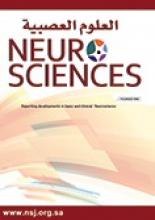Research ArticleOriginal Article
Open Access
Exploring physiotherapist’s ability to identify cauda equina syndrome early
Khalid F. Althobaiti, Joshua R. Zadro, Fahad A. Alzhrani and Hosam A. Alzahrani
Neurosciences Journal April 2025, 30 (2) 101-107; DOI: https://doi.org/10.17712/nsj.2025.2.20240035
Khalid F. Althobaiti
From the Department of Rehabilitation and Physiotherapy (Althobaiti, Alzhrani), King Fisal Medical Complex, Department of Physical Therapy (Alzahrani), College of Applied Medical Sciences, Taif University, Taif, Kingdom of Saudi Arabia, and from Sydney Musculoskeletal Health (Zadro), Institute for Musculoskeletal Health, Sydney School of Public Health, Faculty of Medicine and Health, The University of Sydney and Sydney Local Health District, Camperdown 2050, Australia
BSc, MScJoshua R. Zadro
From the Department of Rehabilitation and Physiotherapy (Althobaiti, Alzhrani), King Fisal Medical Complex, Department of Physical Therapy (Alzahrani), College of Applied Medical Sciences, Taif University, Taif, Kingdom of Saudi Arabia, and from Sydney Musculoskeletal Health (Zadro), Institute for Musculoskeletal Health, Sydney School of Public Health, Faculty of Medicine and Health, The University of Sydney and Sydney Local Health District, Camperdown 2050, Australia
BAppSc, PhDFahad A. Alzhrani
From the Department of Rehabilitation and Physiotherapy (Althobaiti, Alzhrani), King Fisal Medical Complex, Department of Physical Therapy (Alzahrani), College of Applied Medical Sciences, Taif University, Taif, Kingdom of Saudi Arabia, and from Sydney Musculoskeletal Health (Zadro), Institute for Musculoskeletal Health, Sydney School of Public Health, Faculty of Medicine and Health, The University of Sydney and Sydney Local Health District, Camperdown 2050, Australia
BSc, MScHosam A. Alzahrani
From the Department of Rehabilitation and Physiotherapy (Althobaiti, Alzhrani), King Fisal Medical Complex, Department of Physical Therapy (Alzahrani), College of Applied Medical Sciences, Taif University, Taif, Kingdom of Saudi Arabia, and from Sydney Musculoskeletal Health (Zadro), Institute for Musculoskeletal Health, Sydney School of Public Health, Faculty of Medicine and Health, The University of Sydney and Sydney Local Health District, Camperdown 2050, Australia
MPT, PhD
References
- 1.↵
- 2.↵
- 3.↵
- 4.↵
- Lavy C,
- James A,
- Wilson-MacDonald J,
- Fairbank J.
- 5.↵
- 6.↵
- 7.↵
- 8.↵
- 9.↵
- 10.↵
- 11.↵
- Buell KG,
- Sivasubramaniyam S,
- Sykes M,
- Zafar K,
- Bingham L,
- Mitra A.
- 12.↵
- Sun JC,
- Xu T,
- Chen KF,
- Qian W,
- Liu K,
- Shi JG, et al.
- 13.↵
- 14.↵
- 15.↵
- 16.↵
- 17.↵
- 18.↵
- 19.
- 20.↵
- 21.
- Greenhalgh S,
- Truman C,
- Webster V,
- Selfe J.
- 22.↵
- 23.↵
- 24.↵
In this issue
Exploring physiotherapist’s ability to identify cauda equina syndrome early
Khalid F. Althobaiti, Joshua R. Zadro, Fahad A. Alzhrani, Hosam A. Alzahrani
Neurosciences Journal Apr 2025, 30 (2) 101-107; DOI: 10.17712/nsj.2025.2.20240035
Jump to section
Related Articles
- No related articles found.
Cited By...
- No citing articles found.





